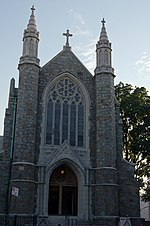Astoria, Queens

Astoria is a neighborhood in the western portion of the New York City borough of Queens. Astoria is bounded by the East River and is adjacent to three other Queens neighborhoods: Long Island City to the southwest, Sunnyside to the southeast, and Woodside to the east. As of 2019, Astoria has an estimated population of 95,446.The area was originally called Hallet's (or Hallett's) Cove after its first landowner William Hallet, who settled there in 1652 with his wife, Elizabeth Fones. Hallet's Cove was incorporated on April 12, 1839, and was later renamed for John Jacob Astor, then the wealthiest man in the United States, in order to persuade him to invest in the area. During the second half of the 19th century, economic and commercial growth brought increased immigration. Astoria and several other surrounding villages were incorporated into Long Island City in 1870, which in turn was incorporated into the City of Greater New York in 1898. Commercial activity continued through the 20th century, with the area being a center for filmmaking and industry. Astoria is located in Queens Community District 1 and its ZIP Codes are 11101, 11102, 11103, 11105, and 11106. It is patrolled by the New York City Police Department's 114th Precinct. Politically, Astoria is represented by the New York City Council's 22nd and 26th Districts.
Excerpt from the Wikipedia article Astoria, Queens (License: CC BY-SA 3.0, Authors, Images).Astoria, Queens
30th Avenue, New York Queens
Geographical coordinates (GPS) Address Nearby Places Show on map
Geographical coordinates (GPS)
| Latitude | Longitude |
|---|---|
| N 40.767 ° | E -73.921 ° |
Address
30th Avenue 31-03
11102 New York, Queens
New York, United States
Open on Google Maps







